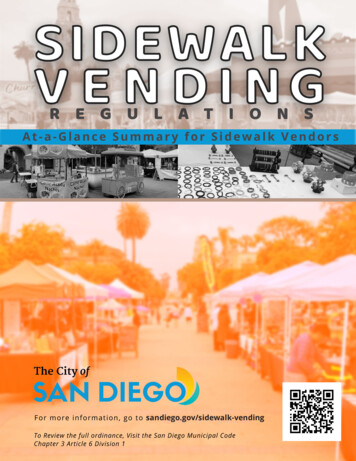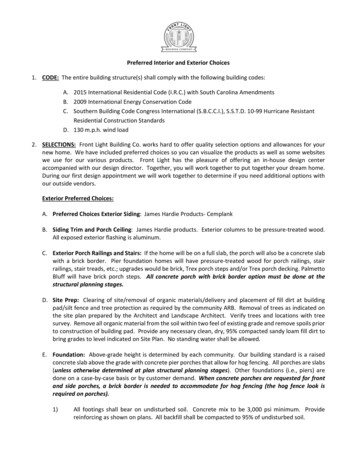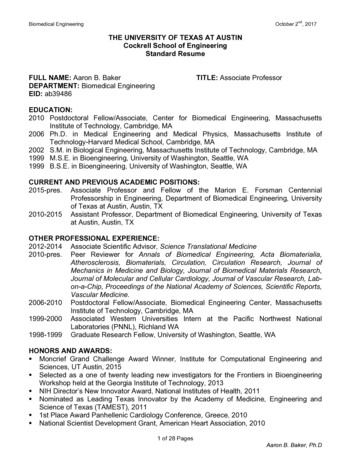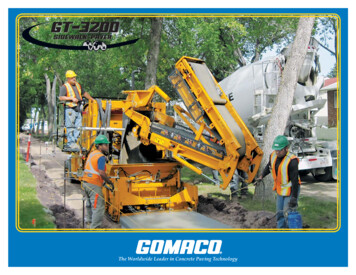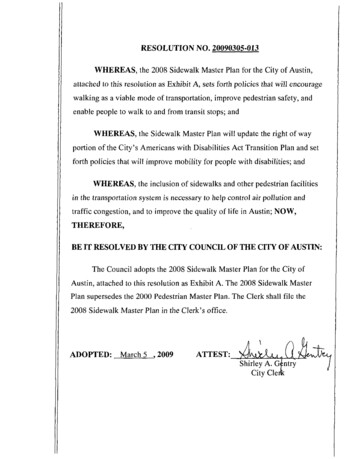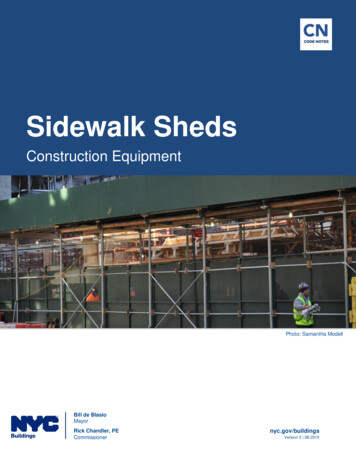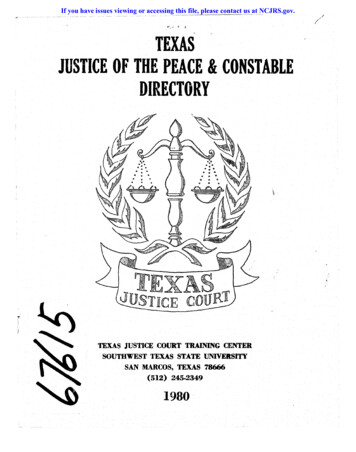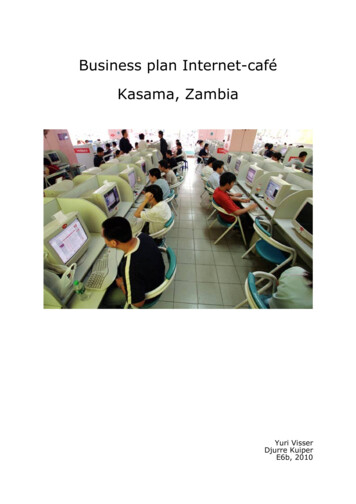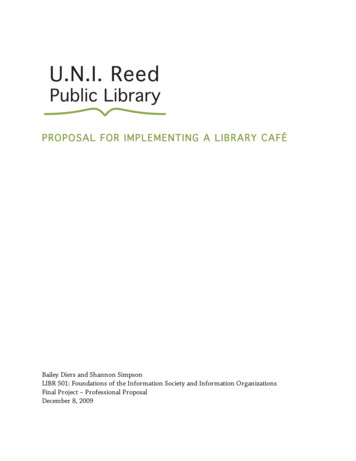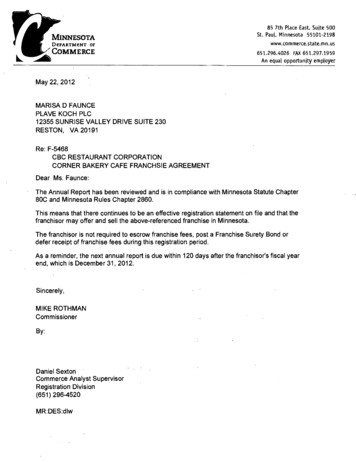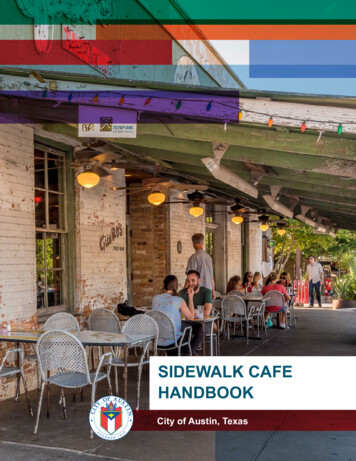
Transcription
SIDEWALK CAFEHANDBOOKCity of Austin, Texas1
About Sidewalk CafesSidewalk cafes contribute to a vibrant city where streets are forpeople. They make Austin’s streets more attractive, lively andcomplete places – where people can relax and enjoy being withtheir friends and neighbors. With Austin’s lively outdoor cultureand appealing year-round weather, sidewalk cafes are popular withpeople of all ages. The opportunity to have a sidewalk cafe supportslocal businesses in downtown and walkable neighborhood businessdistricts. Having people on the street, enjoying sidewalk cafes, alsocan help to make streets safer, and the cafes serve as attractive,walkable destinations.The design guidelines and details on design requirements that follow in thishandbook will help to ensure that your cafe is a success and that the City’sapplication, review, and approval process goes smoothly.In Austin, sidewalk cafes may be operated by restaurants or other businessesthat are licensed to serve food and beverages, including alcohol. The cafe spaceis privately managed by the business, open for use only by its customers, andseparated off with barriers. Table service may be provided.A Street Patio is a specific type of sidewalk cafe. It is installed in street spaceformerly dedicated to parking but converted for pedestrian-oriented use.Please see the Temporary Sidewalk Cafe Permit Website for the StreetPatio Handbook.2Photo credit: Michael Knox
Getting City Approvalfor a Sidewalk CafeAll sidewalk cafes installed on a City sidewalk, or other areas of the public rightof way, require either a permit or a license agreement from the City. An outdoorcafe sited entirely on private property does not require a Right of Way permit or alicense agreement between the owner and the City of Austin Office of Real EstateServices (ORES).Obtaining a Temporary Sidewalk Cafe permit is the quickest path to obtaining permission fromthe City of Austin. The less burdensome permitting process was launched in 2014, specifically toassist business owners in creating temporary sidewalk cafes. Use the application form providedby Austin Transportation Department’s Right of Way Management Division, which issuesthe permits in accordance with City Code § 14-4-3, Ordinance No. 20140828-074 Permittingof Temporary Sidewalk Cafes. For comparison, the differences between temporary andpermanent sidewalk cafes include:Temporary Sidewalk Cafe Permit: Duration: Permit may be obtained for one to five years. Process: Streamlined and simpler permit approval process. Reviewing Department: Austin Transportation Department, Right of WayManagement Division. Note that additional Departments may be included,depending on the design complexity, proposed cafe furniture and elements, and/orproximity to utility infrastructure. Installation: To be temporary, the cafe structure must include removable barriersthat are affixed to the sidewalk with no more than one bolt in each corner of the cafespace, with a four bolt maximum. Fees: 100 application fee and 200 annual permit fee.Permanent Sidewalk Cafe License Agreement: Duration: Allows a business to operate a sidewalk cafe throughout the lifespan ofthe business. Process: More in-depth and lengthy. Requires construction drawings. Reviewing Department: Office of Real Estate Services (ORES). Installation: A license agreement is required when the physical cafe structure ismore permanently affixed to the sidewalk – e.g. it requires more than one bolt ineach corner, is attached to the building, or it includes an outdoor bar structure in thesidewalk cafe area. Fees: 425 application fee and an annual fee.ORES Contacts: Andy Halm, 512.974.7185 or Betty Nguyen, 512.974.7196This handbook addresses only temporary sidewalk cafes, as permitted by Austin TransportationDepartment.3
Insurance and BondRequirementsPlease consult the requirements for Insurance, Bond, and License packet. It isavailable online at rmits andit includes further details and templates.BOND REQUIREMENTSThe sidewalk cafe permit holder must provide the City with cash or a surety bond sufficient tocover the cost to the City to remove the sidewalk cafe if necessary. Requirements depend onthe style of cafe barrier: 5,000 bond if unbolted 10,000 bond if boltedLIABILITY INSURANCE REQUIREMENTAs is required for other City street use permits, the applicant business must carry 500,000 incommercial general liability insurance. A business that sells alcohol must also carry 1,000,000in Liquor Liability Insurance. The policy must name the City of Austin as an “additional insured”and include a “30 day notice of cancellation.”The applicant must provide a certificate of liability insurance before the City can issue thepermit. This coverage must be maintained throughout the duration of the permit and forsix months after the cafe is removed. For more information, please see the Right of WayManagement’s Requirements for Insurance, Bond, and License at the website above.MAINTENANCE AGREEMENTObtaining a sidewalk cafe permit also requires signing a maintenance agreement. Please seethe maintenance agreement for details.4
Designing YourTemporarySidewalk Cafe5Photo credit: Michael Knox
A sidewalk cafe can be relatively simple and low-cost, or a more elaborate space with durableelements and furnishings. As part of the public’s daily experience of the street, the cafeshould be inviting and promote street activity. Cafes in outdoor locations with people-watchingopportunities tend to be the most popular. Streets with some foot traffic, in areas with storefrontbusinesses and transit stops, are ideal. Using small tables allows for more patrons and anintimate cafe experience. Movable seating allows patrons to adjust their seating arrangementfor comfort, sun exposure, etc. Look at a variety of outdoor cafes for ideas in designing yourspace, including the photos in this handbook and many others available in books and online.The Design Requirements that follow discuss the required elements, which are critical tothe outdoor space’s attractiveness and success. Be sure to consider: Whether the site can meet all design, setback, and clearance design requirements Sun orientation and exposure; awnings, umbrellas and/or other provisions for rain Selection of barriers, planters, and other methods of cafe delineation Materials, furnishings and landscapingThe physical barrier, which can be established with corner planters or fencing, provides a levelof separation, which helps people understand the cafe boundaries and clearly identifies it as anextension of the adjacent indoor restaurant.APPLICATION PROCESSThis handbook contains background information about application requirements and preparingyour site. See the application form for further details about the City process for submittal,review, and approval.To obtain the necessary permit, submit a completed Temporary Sidewalk Cafe ApplicationForm to the Right of Way Management Division, Austin Transportation Department, at theaddress below. Only businesses with approved permits are allowed to operate Sidewalk Cafesin the City’s Right of Way.Please read through the handbook, the application form, and all attachments; if you still needadditional information, contact:Right Of Way Management Division, 512-974-11503701 Lake Austin Blvd., Austin, TX 78703Walk-in Hours – Monday through Friday, 8 a.m. to 1 p.m. (no appointment required)The completed application form, supporting documentation, and a check for the non-refundable 100 application fee will need to be delivered to this office.6
PERMIT PROCESS FLOWCHARTReview DesignRequirementsIf your site islocated on:Submit anapplication withrequired information 6th Street fromIH 35 to CongressSend drawings toWalk of Starsrepresentative(see application) Trinity from CesarChavez Street to 6thStreetAND/ORProvide proofof propertyownershipIf your site islocated on: 6th Street fromIH 35 to Lavaca StreetProvide listof adjacentbusinesses Trinity Street from6th to 7th Street 5th Street fromNeches to Red RiverProvide writtencommentsfrom adjacentbusinessesProvide a photo ofexisting siteSend drawings toHistoric PreservationOfficer (seeapplication)Provide a drawingof proposed cafeProvide list of allsite materialsAll OtherLocationsVisit Right of Wayoffice and submitapplication with fee( 100)Once application has beenreviewed and approved,follow the next stepsAre youserving alcohol?NoProvide proof of 500,000 generalliability insuranceYesProvide proof of 500,000 generalliability insuranceand additional 1,000,000 liquorliability insuranceand copy of TABCpermitInstall your TemporarySidewalk Café!Is your café bolted tothe sidewalk or street?No?Yes?Provide proof of 5,000 bondProvide proof of 10,000 bondPay annual fee(s) and provide proof ofinsurance and bond to the Right of Way office.7
SIDEWALK CAFE DESIGN REQUIREMENTSIllustration of a design permissiblefor a sidewalk cafe that serves beerand wine. Note the 3’ height of theend-cap barriers, the 6’ minimumpedestrian clearance required onthe remaining sidewalk, and the 3’(36”) minimum size of the entranceopening (for ADA accessibility.)3’ minimumentry sizeSite and CurbClearance3’ high endcap barriers6’ minimumpedestrianclearanceThe sidewalk and street are part of the public right of way. On behalf of the public, the City ofAustin regulates its use. As part of the Sidewalk Cafe permit review process, the proposedsite and design will be reviewed to ensure that they meet all design, setback, and clearancerequirements.If the proposed sidewalk cafe would cover manholes or encroach upon public utilities, it will besubject to additional review. Additional time will be necessary.A Sidewalk Cafe cannot interfere with other curb uses. Examine the proposed area for anyconflicts along the curb, in advance. Conflicts with existing curb uses that will result in denial ofthe permit application include a conflict with a: fire hydrant bus stop or transit station loading zone taxi zones handicap-access parking space other specially designated zone8
BarriersSidewalk cafes that do not serve alcohol may simply consist of tables and chairs. They donot need physical barriers that define the space, although planters or other barriers may beincluded in the design.The tables and chairs must be sized and arranged to ensure six feet of sidewalk remainsclear for a pedestrian passageway.Photo credit: Michael KnoxSIDEWALK CAFES SERVING ALCOHOLPer TABC requirements, the City of Austin requires physical barriers that delineate the spacewhere alcoholic beverages are served in a sidewalk cafe. Table service with alcohol is limited tothe area defined by the delineated perimeter and alcohol may not leave that area.To delineate and visually separate the space, two end-cap barriers are required, one at eachexterior corner (or end) of the sidewalk cafe. The designated sidewalk area is established bythe outside corners of the two end-cap barriers. A fully enclosed cafe space, defined with afenced barrier, is encouraged but not required.At its simplest, per TABC guidance, the delineated perimeter is an imaginary line that can beestablished by two planters set in the outside corners of the designated sidewalk area.9
The delineation of this spacewith two end-cap plantersmeets the requirement foralcohol service.Photo credit: San Francisco Public Works DepartmentBARRIER DESIGNRemovable barriers should be a minimum of 36 inches in height. They must be free-standing,stable, and well-balanced. Ensure that the barrier is solidly designed so that it’s difficult totopple or remove, and it does not create a tripping hazard. For safety, barrier segment edgesshould be flat with tapered edges that are between ¼ and ½ inch thick, with no sharp edges.Height: Sidewalk cafe posts, planters, and/or fence sections shall be a minimum of 36inches (3 feet) in height.Distance from the Ground: The distance from the lowest point of the fencing to theground shall be no more than 6 inches in height. This is to ensure that visually-impairedpedestrians who use canes will note the barrier.Open Design: Sidewalk cafe fences shall allow patrons and pedestrians to see from thecafe to the street and vice versa.Types of Barriers1. Sectional fencing: Rigid fence segments may be placed end-to-end to createthe appearance of a single fence. Sectional fencing should be composed of metal orfinished wood.10
This sidewalk cafe at Numero 28, in the Second Street District, was designed with modularcomponents. They are designed to be stable, but not bolted to the sidewalk, thus meeting therequirements for a temporary permit.Photo credit: Hilary AndersenAnnie’s Cafe on Congress Avenuedelineates its sidewalk cafe spaceentirely with planters.Photo credit: Michael Knox11
2. Planters: Outdoor planters may be used as a barrier component. If placed at thecorners of the sidewalk cafe space, they can serve to delineate it. A planter with plantsshould be a minimum of 3 feet tall; in total it may not be taller than 6 feet. The businessshould plan ahead for the regular watering and other maintenance required to keep theplants healthy, pruned, and free of trash and debris.A sidewalk cafe withplanters at either end.Photo credit: Hilary Andersen12
ENTRANCE AND ACCESS OPENINGSThe sidewalk cafe entrance should be in front of the adjacent restaurant. Ensure that deliveriesdo not obstruct or interfere with the entrance. Furnishings may not obstruct doorways andaccess openings.Minimum entrance width: 36 inches wide for ADA and wheelchair accessibility.36” minimumaccess opening3’ barrierheight6’ minimumpedestrianclearance(18’ sidewalk)6” from bottom ofbarrier to groundThis illustration shows a sidewalk cafe thatmeets design requirements, as it relates to thesidewalk, planting strip, and street.SETBACKS FROM OTHER BUSINESSESRestaurant and cafe managers should ensure that sidewalk cafes do not unreasonablyobstruct the visibility of neighboring businesses. The sidewalk cafe area must remain within thestorefront boundaries of the business.CLEAR PEDESTRIAN PASSAGEWAYWhere sidewalks are 18 feet wide or greater, the delineated cafe space must be sized to leavea minimum of six feet of unobstructed pedestrian passageway on the sidewalk. This appliesto Great Streets with 18-foot sidewalks in Downtown Austin.13
Where sidewalks are narrower, the sidewalk cafe must be designed and delineated so that itleaves a minimum of five feet of unobstructed pedestrian passageway on the sidewalk.The clear pedestrian passageway must be maintained and designated at all times. No elementof the sidewalk cafe (including umbrellas, canopy, plants, barriers, or signs) may obstruct thepedestrian passage way.This sidewalk cafe, found across from the Whitney Museumin New York City, adds springtime color to the street withsmall flowering trees planted in inexpensive but fun trashcans and barrels. The plantings are changed out seasonally.Photo credit: Katherine GregorBased on the site review, the City reserves the right to require a wider pedestrian passagewayof up to six feet if in areas that anticipate a high level of pedestrian activity.FURNISHINGSSelect high-quality materials, furniture, and fixtures that enhance the streetscape; your materialsshould be appropriate to the neighborhood as well as the character of your business. Furnituremust be highly durable and intended for outdoor use in the Texas weather.Maintain the furniture and fixtures daily, to ensure they are clean and free of fading, corrosion,splinters, dents, tears, and chipped paint.All seating and tables must be movable in order to accommodate wheelchair access.14
Clean, sturdy, comfortable andmoveable chairs and tablesPhoto credit: Hilary AndersenTABLES AND CHAIRSSeating should be comfortable and moveable, and designed to withstand heavy use andweather. Tables may be any shape. They may not be over 36 inches in height.Smaller tables are encouraged, as they provide more layout flexibility. They can be combinedfor larger parties.MATERIALSThe application submitted must include a list of all materials to be used in your sidewalk cafe.Materials that appear unsuitable for sustained outdoor use (e.g. untreated wood likely toquickly splinter) will be questioned during application review. For sustainability, select materialsthat will last, rather than those likely to end up in the landfill and be replaced.Encouraged materials: Metals, finish-grade woods, sturdy recycled materialsDiscouraged materials: Breakable plastics, unfinished lumberEncouraged materialDiscouraged material15Photo credit: Hilary Andersen
UMBRELLAS AND CANOPIESFunctional and aesthetically pleasing umbrellas and shade structures make sidewalk cafescomfortable year-round for patrons.Umbrellas must be contained within the defined sidewalk cafe area. Square or rectangularmarket-style umbrellas are recommended for sidewalk cafes for space-efficient design. Theumbrella fabric should be canvas or fabric engineered for a long life in outdoor conditions.When open, umbrellas should be between seven and 10 feet tall.A durable canopy, awning, or shade sail may be installed over the delineated area of thesidewalk cafe. It must be at least seven feet, but no higher than 15 feet from the ground.Left: This Italiancafe in theSecond StreetDistrict includesa canopy/enclosure, whichis closed snugin winter butopened in fairweather, and hasfestive umbrellasalong the streetedge.Photo credit: Hilary AndersenRight: At LamarUnion, this interiorstreet (technicallya private drive) isenlivened by itssidewalk cafe, whichoffers a choice ofshaded or sunnytables. The classicbistro style furniturehas a small footprinton the sidewalk.16Photo credit: Katherine Gregor
SURFACE OF SIDEWALKWithin the sidewalk cafe space, the existing sidewalk or paver surface must be maintained. Toensure wheelchair accessibility and prevent tripping hazards, the City prohibits artificial turf orcarpet in sidewalk cafe areas. City sidewalks cannot be painted.PLEASE NOTE: All Sidewalk Cafe requirements, review processes and fees, application evaluation criteria, andhost responsibilities listed in this handbook are subject to change. Austin Transportation Department reserves theright to amend any aspect of these guidelines at any time. Applicants who do not find the amended terms acceptablemay withdraw their applications.17
About Sidewalk Cafes Sidewalk cafes contribute to a vibrant city where streets are for people. They make Austin's streets more attractive, lively and complete places - where people can relax and enjoy being with their friends and neighbors. With Austin's lively outdoor culture and appealing year-round weather, sidewalk cafes are popular with
